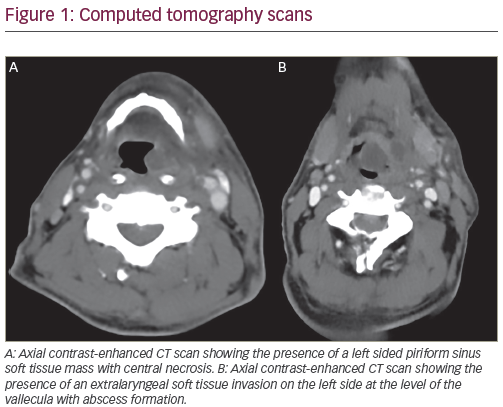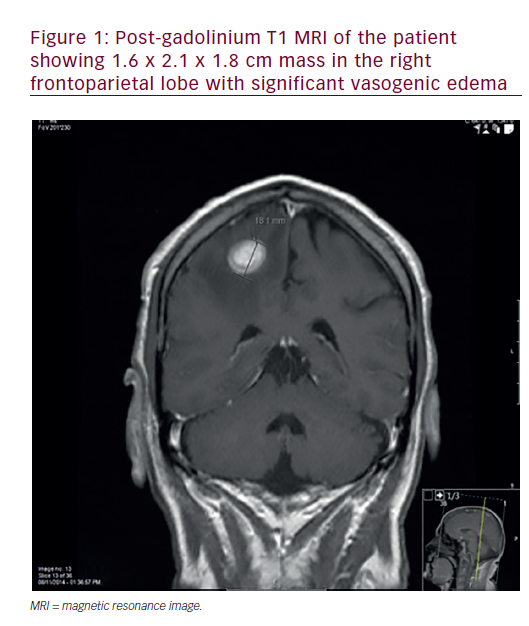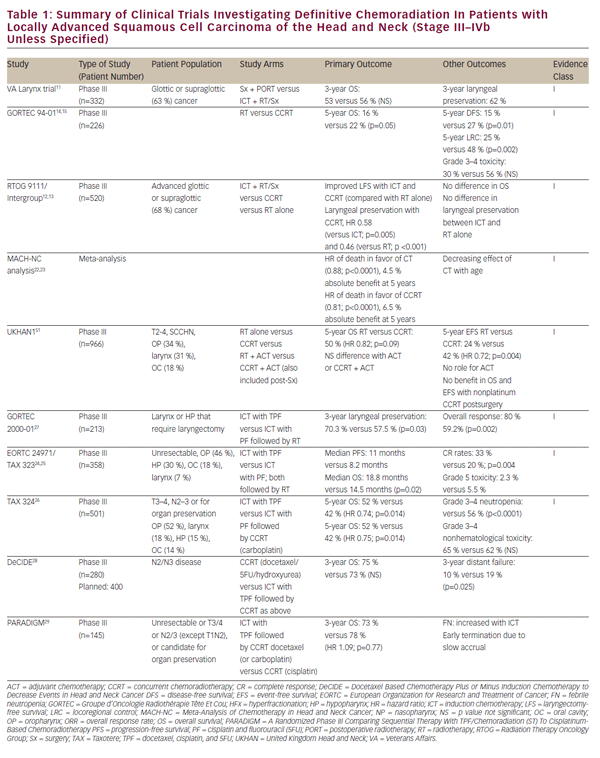As 90% of all cases of squamous cell cancer of the head and neck (SCCHN) show (over-) expression of epidermal growth factor receptor (EGFR), there is a strong rationale supporting the targeting of EGFR in this malignancy. This rationale is further strengthened by the fact thatEGFR overexpression is associated with a worse prognosis.1,2 The EGFR molecule consists of an N-terminal, extracellular, ligand-binding domain, a hydrophobic, transmembrane domain and a C-terminal, intracellular domain with tyrosine kinase activity. The EGFR can be stimulated by several growth factors, such as transforming growth factor (TGF)-α and EGF, which bind to the extracellular domain of the receptor. This ligand binding results in EGFR dimerisation and activation of the tyrosine kinase domains present on each receptor. This kinase activation results in cross-phosphorylation of tyrosine residues on each member of the receptor pair and initiates the formation of signalling complexes in the cytoplasm that can translocate to the cell nucleus and activate gene transcription. This editing of gene transcription eventually results in the induction of several cellular responses such as cell proliferation. Ultimately, receptor–ligand complexes are internalised and the signal terminated.3
Currently, two EGFR-targeting strategies are used in clinical practice: monoclonal antibodies (MAbs) directed at the extracellular domain of the receptor, and small-molecule, adenosine triphosphate (ATP)- competitive tyrosine kinase inhibitors (TKIs).4 Thus far, the monoclonal EGFR antibody cetuximab has been studied in most detail. Cetuximab is a human–murine chimeric immunoglobulin G1 (IgG1) monoclonal antibody that competitively binds to the extracellular domain of the EGFR, preventing activation of the receptor by endogenous ligands. The antibody–receptor complex is internalised and degraded, resulting in downregulation of EGFR expression.5
Cetuximab and Chemotherapy – Pre-clinical Data
Pre-clinical data support the combined use of EGFR-directed agents and chemotherapy in SCCHN. Takaoka et al.6 investigated the effects of combining cetuximab or an EGFR-selective TKI (AG1478) with cisplatin in the oral SCC (OSCC) cell lines NA and Ca9–22. OSCC cell proliferation was inhibited by cetuximab, AG1478 and cisplatin in a dose-dependent manner. The combination of cetuximab or AG1478 with cisplatin at concentrations under the median inhibition concentration (IC50) acted synergistically on the inhibition of cell proliferation and the induction of apoptosis in these cells. EGFR inhibitors downregulated the expression levels of the anti-apoptotic proteins IAP-1 (cIAP-1), X-linked IAP (XIAP), Bcl-2 and Bcl-xL, whereas levels of the proapoptotic proteins Bax and Bak were upregulated. Synergy between cetuximab and cisplatin was also observed in an A431 xenograft model.7
First Experiences with Cetuximab and Cisplatin in the Clinic
Shin et al.8 treated 12 patients with recurrent and/or metastatic SCCHN with a combination of cisplatin and cetuximab at three dose levels in a phase I setting and assessed the tumour EGFR saturation. The 400mg/m2 loading dose of cetuximab followed by weekly doses of 250mg/m2 achieved a high percentage of saturation of EGFR in tumour tissue, and these doses were recommended for phase II and III clinical trials. Six of nine evaluable patients (67%) achieved major responses, including two complete responses (22%).
Cetuximab and Cisplatin in Recurrent and/or Metastatic Head and Neck Cancer – First-line Treatment
Bourhis et al.9 enrolled 53 patients onto a phase I/II study of cetuximab (400mg/m2 loading dose followed by weekly doses of 250mg/m2) in combination with carboplatin at an area under the curve (AUC) of 5mg/ml.min or cisplatin 100mg/m2, administered every three weeks, each followed by a five-day infusion of 5-fluorouracil at escalating doses of 600, 800 and 1000mg/m2/day. The combination was well tolerated and a 5-fluorouracil dose of 1,000mg/m2/day was recommended for further studies. The overall response rate was 36%. A summary of randomised phase III trials in recurrent/metastatic SCCHN is given in Table 1. The Eastern Cooperative Oncology Group (ECOG) (Burtness et al.10) assigned 123 patients (117 of whom were eligible and analysable) to 100mg/m2 cisplatin every four weeks combined with weekly cetuximab (400mg/m2 loading dose followed by weekly doses of 250mg/m2) or placebo. Patients were stratified for performance status and disease status (previously treated or untreated). However, 30% of the patients in the cisplatin plus cetuximab arm versus 15% in the cisplatin plus placebo arm had received prior systemic therapy as either adjuvant or induction chemotherapy. The primary end-point of this study was progression-free survival (PFS). The study was designed to detect with 90% power a difference in median PFS of two months between the cisplatin plus placebo arm and the cisplatin plus cetuximab arm (from two months to four months), using a one-sided log-rank test with an overall type I error rate of 0.025. However, the observed median PFS in the control arm was higher than expected (2.7 months). As the median PFS for the cetuximab arm was 4.2 months, the difference did not reach statistical significance (p=0.09). Due to the longer PFS in the control arm, the power to detect a two-month difference in PFS was decreased to 50%.10 Median overall survival was also not significantly different (9.2 versus 8 months; p=0.21). However, the objective response rate was superior in the cisplatin/cetuximab arm (26 versus 10%; p=0.03). Interestingly, development of cetuximab-related skin toxicity was associated with an improved overall survival (hazard ratio 0.42; p=0.01).
In the EXTREME study (Vermorken et al.11), 442 patients were randomised to 100mg/m2 cisplatin or carboplatin at an AUC of 5mg/ml.min on day one followed by 1,000mg/m2/day 5-fluorouracil for four days alone or combined with weekly cetuximab (400mg/m2 loading dose followed by weekly doses of 250mg/m2). Cycles were repeated every three weeks to a maximum of six. In the combination arm, cetuximab was continued as a single agent until disease progression or unacceptable toxicity was observed. Patients with recurrent and/or metastatic SCCHN with measurable disease and a Karnofsky score of at least 70 were eligible. All patients who had received prior chemotherapy were excluded from the study, except those who had received chemotherapy as part of their primary treatment for locally advanced disease, provided this chemotherapy was ended at least six months before inclusion in this trial. The primary end-point was overall survival. The study was designed to detect an increase in median survival from 7 to 9.5 months with 80% power at a 5% two-sided significance level. The EXTREME trial was the first study in over 30 years to show a significant improvement of overall survival in the first-line treatment of recurrent and/or metastatic SCCHN. The addition of cetuximab to platinum-based chemotherapy increased the median overall survival by 2.7 months, from 7.4 to 10.1 months (hazard ratio 0.8; p=0.04). With the addition of cetuximab, the response rate increased from 20 to 36% (p<0.0001) and the disease control rate increased from 60 to 81% (p<0.001). The median PFS was prolonged by 2.3 months from 3.3 to 5.6 months (p<0.001). Subgroup analyses indicated that the benefit of adding cetuximab to platinum–fluorouracil chemotherapy was evident in most of the subgroups.The hazard ratios for PFS showed a uniformly positive effect of adding cetuximab in all subgroups, with hazard ratios ranging from 0.34 to 0.80. Pre-planned multivariate analysis identified the Karnofsky score as having the greatest prognostic impact on overall survival time. A Karnofsky score of 80 or more reduced the risk of death by 49% compared with a Karnofsky score of less than 80 (hazard ratio 0.51, 95% confidence interval [CI] 0.37–0.69; p<0.001). There was no significant difference in survival between the patients with only metastatic or recurrent metastatic disease versus those with only locoregionally recurrent disease (p=0.06). The treatment effect seen in the multivariate model (hazard ratio for progression 0.79, 95% CI 0.64–0.97; p=0.03) confirmed the effect seen in the primary analysis. The addition of cetuximab did not effect the overall incidence of grade 3 or 4 adverse events compared with platinumbased chemotherapy alone, except for the incidence of grade 3 or 4 sepsis. There were 9 cases of grade 3 or 4 sepsis in the chemotherapy plus cetuximab group, and only 1 in the chemotherapy group (p=0.02). The main additional grade 3 or 4 adverse events, including skin reactions, were consistent with the side-effect profile of cetuximab. The addition of cetuximab did not have a negative impact on quality of life. Compliance with questionnaire completion was low at each time-point (≤50% post-baseline), although rates were higher in the cetuximab arm.12 EGFR-inhibitor-induced skin toxicity can best be managed by adhering to widely accepted guidelines.13
Thus far, no biomarkers predictive for sensitivity of SCCHN to EGFR inhibition have been identified. In the EXTREME study, EGFR gene copy number, as determined by fluorescent in situ hybridisation (FISH), was not a predictive biomarker for cetuximab efficacy.14
It is unclear whether the results of the EXTREME study can be extrapolated to a population of patients who received cetuximab as part of their initial treatment. It is also unclear whether the addition of cetuximab to non-platinum-containing regimens as first-line treatment for recurrent/metastatic disease also confers a better outcome. The Spanish Head and Neck Cancer Group15 combined cetuximab (400mg/m2 loading dose followed by weekly doses of 250mg/m2) with paclitaxel at a weekly dose of 80mg/m2. Forty-six patients were treated; however, only 35 patients were evaluable for response. The response rate in this evaluable patient population was 71%.
Cetuximab in Recurrent and/or Metastatic Head and Neck Cancer – Second-line Treatment
Cetuximab was first tested in SCCHN in patients with platinumrefractory or -resistant disease. All patients received cetuximab intravenously at an initial loading dose of 400mg/m2 followed by weekly doses of 250mg/m2. Vermorken et al.16 compared the efficacy data from three prospective studies (n=278 patients) that administered cetuximab as a single agent (n=103 patients) or combined with either cisplatin or carboplatin (n=96 patients) or cisplatin (n=79 patients) with the results from a retrospective study of patients who received various second-line treatments (all treatments including best supportive care only: n=151 patients; including chemotherapy: n=43 patients). The three cetuximab trials showed an overall response rate ranging from 10 to 13% and a disease control rate that ranged from 46 to 56%. The median time to disease progression ranged between 2.2 and 2.8 months, and the median overall survival between 5.2 and 6.1 months. None of the patients who progressed on cetuximab alone responded to additional platinum. These survival data compared favourably with those from the retrospective study (median survival 3.4 months for all patients and 3.6 months for those treated with chemotherapy). Buentzel et al.17 treated 23 patients with disease recurrence after platinum-based chemotherapy with weekly cetuximab (400mg/m2 loading dose followed by weekly doses of 250mg/m2) in combination with carboplatin 200mg/m2 and paclitaxel (200mg/m2) every three weeks and observed an objective response rate of 35% in these patients. The median overall survival was eight months. Knoedler et al.18 treated 84 platinum-pre-treated patients with weekly cetuximab (400mg/m2 loading dose followed by weekly doses of 250mg/m2) and docetaxel 35mg/m2 on days one, eight and 15 of a four-week cycle. Partial responses and disease control according to Response Evaluation Criteria in Solid Tumors (RECIST) were observed in 12 and 27%, respectively. Median progression-free survival was four months and median overall survival was seven months. Responsiveness to the docetaxel/cetuximab combination seemed to be independent of platinum sensitivity in first-line treatment.
Other EGFR-directed Monoclonal Antibodies
Several other EGFR-directed monoclonal antibodies, including zalutumumab and panitumumab, are under investigation in SCCHN, in both first- and second-line treatment for recurrent/metastatic disease. Panitumumab is a fully human EGFR-directed monoclonal antibody. In the SPECTRUM study,19 patients with recurrent and/or metastatic SCCHN are randomised between cisplatin/5-fluorouracil and the same regimen in combination with panitumumab. The combination has been found to be safe. Accrual has been completed and efficacy data are expected to be presented later this year or next year.
EGFRvIII
EGFRvIII involves deletion of exon 2-7A, which encodes for the ligandand monoclonal antibody-binding extracellular domain of EGFR. The importance of the EGFRvIII mutation in head and neck cancer is unclear. Sok et al.20 detected EGFRvIII expression in 14 of a series of 33 SCCHN tumours. EGFRvIII-transfected SCCHN cells showed decreased apoptosis in response to cisplatin and decreased growth inhibition following treatment with cetuximab compared with vectortransfected control cells. However, we did not find any confirmatory publications on the presence of the EGFRvIII mutation in SCCHN since the initial publication by Sok et al. in 2006.
EGFR Tyrosine Kinases
Sensitising EGFR mutations in exon 19 or exon 21, which are strongly correlated with response to TKIs in non-small-cell lung cancer, are rarely detected in SCCHN.4,21–23 As can probably be expected, the activity of the EGFR TKIs gefitinib and erlotinib as single agents in SCCHN is modest, with overall response rates of less than 10% and a median overall survival of about six months.24–26 Stewart et al.26 randomly assigned 486 patients with metastatic or recurrent SCCHN to gefitinib 250 or 500mg/day or methotrexate 40mg/m2 intravenously weekly. The median overall survival was 5.6, 6.0 and 6.7 months, respectively. The overall response rate was 2.7, 7.6 and 3.9%, respectively, with no statistically significant difference between either gefitinib arm or methotrexate.
Erlotinib was combined with cisplatin every three weeks in a phase I/II study conducted by the National Cancer Institute of Canada (NCI Canada)27 in chemo-naïve patients with recurrent and/or metastatic SCCHN. The recommended phase II dose was erlotinib 100mg/day and cisplatin 75mg/m2. The overall response rate was 21% and the disease control rate was 70%. Median PFS and median overall survival were 3.3 and 7.9 months, respectively. The outcome was better in patients who developed skin rashes during cycle one.
Kim et al.28 treated 50 patients with docetaxel 75mg/m2 and cisplatin 75mg/m2 intravenously every three weeks and erlotinib 150mg by mouth daily. Patients had had no previous EGFR therapy or chemotherapy for recurrent/metastatic disease. The overall response rate was 67% and the disease control rate was 95%. After a follow-up of 19 months, median overall survival was 11 months and PFS was six months. Two hundred and seventy patients were enrolled in a randomised, placebo-controlled phase III trial conducted by ECOG.29 Patients were randomly assigned to receive docetaxel 35mg/m2 intravenously on days one, eight and 15 every 28 days plus placebo or the same regimen plus gefitinib 250mg orally once daily until disease progression. Seventy-two per cent of the patients had received prior chemotherapy. Median overall survival was 6 months with placebo (arm A) versus 6.8 months with gefitinib (arm B). The objective response rate was 6% in arm A versus 14% in arm B (p=0.16). Median time to progression was 2 and 3.5 months, respectively (p=0.03). A randomised phase III trial of platinum-based chemotherapy with or without erlotinib as first-line treatment for recurrent/metastatic SCCHN is ongoing.30
Vascular Endothelial Growth Factor
Up to 90% of SCCHN express the vascular endothelial growth factor (VEGF) or VEGF receptors (VEGFR) 1–3.31 Angiogenic factors could have prognostic implications, making anti-angiogenic therapies an attractive treatment modality. Sunitinib and sorafenib inhibit multiple tyrosine kinase receptors including VEGFR and platelet-derived growth factor receptor (PDGFR). However, the activity of sunitib and sorafenib in SCCHN is modest at best.32–36 GORTEC observed an unacceptable toxicity rate in a phase II trial with sunitinib, with grade 4 and grade 5 tumour bleeding occurring in 5 and 11% of patients, respectively. Tumour skin ulcerations and/or fistula occurred or worsened in 41% of the patients. Promising but preliminary results were presented with cediranib, an oral, highly potent and selective inhibitor of VEGFR-1–3.37
Other Targeted Therapies
Multiple other targeted agents are under investigation in head and neck cancer. Thus far, disappointing results have been reported for most of them, including bortezomib, which inhibits the activation of nuclear factor kappa B (NF-κβ),38 and dasatinib, which is a potent inhibitor of src-family kinases, ephA2, PDGFR, Abl and c-kit.39
Dual Pathway Inhibition
Dual pathway inhibition is gaining considerable interest, as inhibition of one pathway probably upregulates alternative pathway signalling. Upregulation of VEGF has been implicated in resistance to EGFR inhibition.40,41 Cohen et al.42 published promising results on the combined use of erlotinib and bevacizumab. Forty-eight patients with recurrent/metastatic SCCHN were treated with erlotinib 150mg/day and bevacizumab 15mg/kg every three weeks. Twenty-seven patients had received prior chemotherapy for recurrent/metastatic disease. The combination was well tolerated, the most common side effects being rash and diarrhoea. Grade 3 bleeding events were observed in three patients. A response was observed in seven patients (15%), with four complete responses (8%). The disease control rate was 62.5%. Median progression-free and overall survival were 4.1 and 7.1 months, respectively. Gibson et al.43 treated 28 patients with recurrent/metastatic SCCHN with weekly cetuximab 250mg/m2 (after a loading dose of 400mg/m2) and bevacizumab 15mg/kg given intravenously every 21 days until disease progression. The objective response rate (primary end-point) was 20% and the disease control rate was 75%. The median overall survival was 8.1 months. The regimen was reasonably well tolerated. It is unclear whether dual pathway inhibition can be safely combined with chemotherapy.
Conclusion
Based on the results of two randomised phase III trials, cetuximab in combination with platinum-based chemotherapy should be considered the new standard first-line regimen for patients with recurrent and/or metastatic disease for whom a platinum-based regimen regimen is considered the best treatment option (evidence level: IA).44 Other EGFRdirected monoclonal antibodies are under investigation. The role of EGFR TKIs in SCCHN is less well established and early data on other targeted agents have also been disappointing thus far. Dual pathway inhibition may overcome resistance to single pathway inhibition. ■






